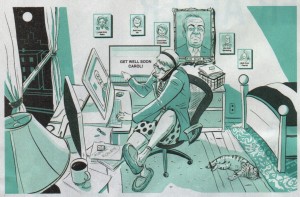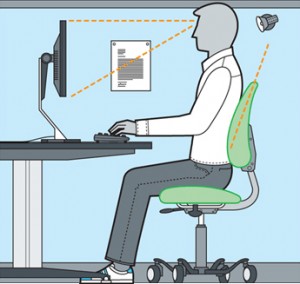Ah, the Remote Teleworker
Illustration by Ryan Inzana
After reading the article by Beth Braverman, Money magazine – Be There – Even When You’re Not, the cartoon depicting a home office isn’t too far off. I know many remote workers who stay in their PJ’s and bathrobe while making those early morning pacific coast calls. It is nice to say you can do all your work in the privacy of your home, but eventually will there be musculoskeletal consequences to pay?
Just to critique the above gentleman, ergonomics looks like it left a long time ago. Posture, what posture? That chair looks like it came from recycling – lower back pain is there by now; crunching the phone to his ear pressed by a shoulder – a stiff neck and misalignment of the cervicals…where is the phone headset? And that keyboard pushed far back on the desk – the hand resting on the desk… has his carpal tunnel shown up yet? And that over- reaching with his leg – hip issues are coming. And the overreaching for his coffee, hope he doesn’t trip over the cat!
Seriously though, repetitive strain injuries (RSI’s) also called musculoskeletal disorders (MSD’s) are the leading cause of ergonomic Worker Compensation (WC) costs. You can change the furniture but until you look at the whole equation of the work area + the Human Body, it is not a complete evaluation to cut these spiraling WC costs.
The Occupational Health and Safety Administration (OSHA) defines MSD’s as injuries and disorders of muscles, nerves, tendons, ligaments, joints, cartilages, and spinal discs. MSD’s are caused by excessive and repeated physical stress on the musculoskeletal system – the hands, wrists, elbows, shoulders, neck, and back.
• According to OSHA, the average cost per incidence of an MSD is estimated to be $12,000, which includes lost work with full wages, replacement wages, lost productivity, and medical treatment (not including surgery). If surgery is required, the average cost bumps up to $43,000 per incidence according to the American Society of Orthopedic Surgeons.
However, these figures DO NOT include the effects of these injuries that are not always easy to see:
• The hidden costs due to slower production, lower quality, job retraining, unemployment, and long-term disabilities.
• Or the lifestyles of millions of people that are affected every year due to the pain and discomfort of these unfortunate injuries; Workers with severe MSD’s often are unable to return to their jobs or even manage the simplest of tasks, such as combing their hair.
Resource: http://www.hermanmiller.com/hm/content/research_summaries/pdfs/wp_ergogoodnews0503.pdf
• An abstract on Office Ergonomics and MSD’s showed a decrease in MSD’s due to ergonomic training.
Applied Ergonomics, Vol.44, No.1, pp.73-85, 2013 ~ Office Ergonomics Training
Even if you work at home, design a work area that is both ergonomically safe and efficient and will keep your body from crying out in discomfort after two hours. The less WC costs for your employer and the possible loss of your job due to having an office like the one up above. Bodily discomforts add up and can reduce your productivity.
Here are a few suggestions that could save your body much agonizing discomfort:
Buy a comfortable chair that fits your body. Remove the arm rests, use a foot rest if necessary, have good lighting, use a document holder so you don’t look down while typing briefs, adjust the backrest to support your lower back, and the knees and arms should be at 90 degree angles. At ERGOhealthy, we use this picture to illustrate proper seated posture while sitting at your desk.
Kate Montgomery owner of Body Maintenance 101.com is a musculoskeletal therapist and a Coach for ERGOhealthy. Our experts work with insurance brokers and companies and deliver online cost effective ergonomic analytics and evaluations with personal service for 6 months. Visit us at ERGOhealthy.com to learn more.





